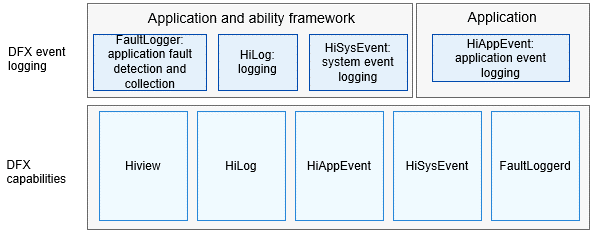DFX
Introduction
Design for X (DFX) refers to the software design that aims to improve the quality attribute in OpenHarmony. It mainly consists of two parts: design for reliability (DFR) and design for testability (DFT).
The DFX subsystem provides the following capabilities:
-
HiLog: Implements logging.
-
Hiview: Functions as the plug-in platform.
-
FaultLoggerd: Implements fault information collection and subscription.
-
HiAppEvent: Implements logging of application events.
-
HiSysEvent: Implements logging of system events.
Architecture
Figure 1 Architecture of the DFX subsystem

Directory Structure
base/hiviewdfx # DFX base repository, which stores compilation-related configurations
├── hiview # Hiview module, which implements the plug-in platform and event handler capabilities
├── hiview_lite # Hiview_Lite module, which implements the logging task capability for the mini system
├── hilog # HiLog module, which implements logging for the system
├── hilog_lite # HiLog_Lite module, which implements logging for the mini and small systems
├── hievent_lite # HiEvent_Lite module, which implements event logging for the mini system
├── hiappevent # HiAppEvent module, which implements application event logging framework and APIs
├── hisysevent # HiSysEvent module, which implements system event logging APIs and services
├── faultloggerd # FaultLoggerd module, which implements collection of application fault logs
Repositories Involved
DFX subsystem